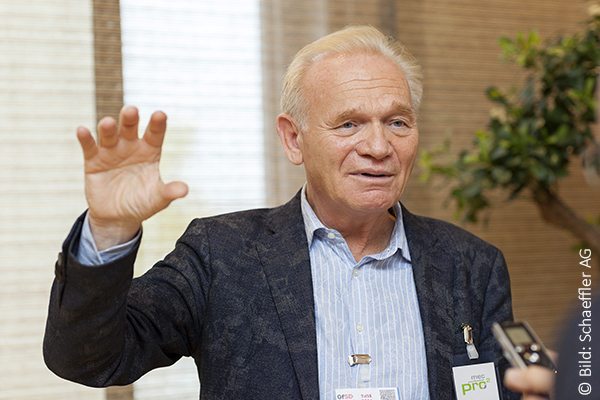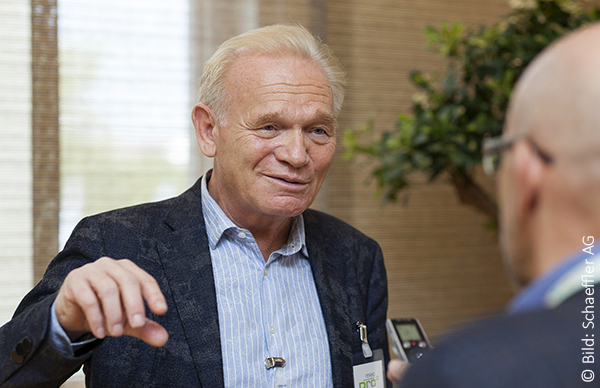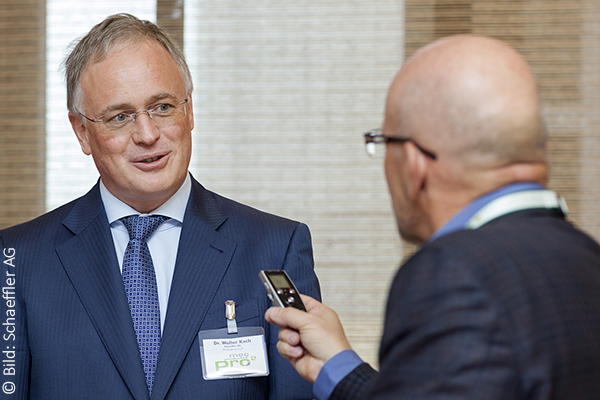
|
Blueprint for the integration of MBSE and PLMAn interwiev with Martin Eigner and Walter Koch For three years, 12 companies and research institutes have joined forces in the mecPro² consortium project sponsored by the German Ministry of Education and Research (BMBF) to examine what a model-based development process for cybertronic products and production systems might look like. Professor Martin Eigner, who initiated the project, and consortium head Dr. Walter Koch from the Schaeffler Group explain the most important results. Question: Professor Eigner, you have already conducted a large number of research projects. Apart from the scale of the project, what was special about mecPro²? Eigner: I can't remember a project involving so many teams where at the beginning I was genuinely concerned that each of them would be working away alone, separate from the others. These concerns were allayed when we started to put our ideas into practice in the two demonstration models. Suddenly everyone who was part of the project was inspired because they could see that it actually works. That is why, for me, the demonstration models are what are special about this project. Question: The start of the project was quite a tough period, as you yourself have mentioned, Dr Koch. What were the main difficulties? Koch: The application phase took more than a year and a half. The result was that many of the experts involved at that stage were no longer available when the project actually kicked off. When we did start, we found that the people who were then involved had very different takes on the project and expectations of it. For example, we had to start off by agreeing on what we all understood by the term "cybertronic products" because we would otherwise not have been speaking the same language. However, I am absolutely convinced that these clarifications were one of the factors behind the project's success and that without them, we would not have been able to move ahead so fast and produce so many results. Question: The project covered a large number of different areas of activity, from the definition of a reference process through to the PLM integration of model-based systems engineering (MBSE). In which of these did you achieve the greatest breakthroughs? 
Eigner: The PLM integration was really a fairly straightforward job. We simply took over the tried-and-tested methods for logical links from the electronic engineering and electronics fields. By contrast, accommodating the existing mechatronics processes was an absolutely Herculean task. It provides a blueprint for any business that wants to implement interdisciplinary processes. In my opinion, the most important result was the descriptive system, that is to say the way in which we have described cybertronic products and production systems in SysML, because this will feed into the standardization of OSLC and other standards. What we managed to do was to extract the very best from nine different systematic approaches. Question: If I have understood correctly, the issue here is the way the modeling is performed in SysML. A type of "cook book"? Eigner: That is correct. Restricting the number of artifacts is a method for improving the way SysML is used. The resulting system can be read into the editor in the form of a profile, after which only these specific elements work. Question: On paper, the reference process seems to be very fine-grained. Have you already implemented it in your organization? Koch: No, not yet. However, we have integrated some of the proven aspects from our present product development process (PDP) for mechatronic products into the draft reference process, for example the modular structure. Because the reference process of the mecPro2 project has a very similar basic structure, we are now in a position to incorporate the new process modules developed within the framework of mecPro² relatively easily in our Schaeffler PDP. Question: Professor Eigner, you just said that the PLM integration was fairly straightforward. However, this is precisely an area in which there are still many open issues and a lack of standards. Were you not able to make any progress here? Eigner: On the contrary. As part of the project, we launched a subproject that is known as KRAKE and operates with REST technology in a very similar way to OSLC. It makes it possible to link information elements such as web pages. I just ask myself why it has taken 17 years for someone to discover this technology for PLM. It will do away with the monolithic PLM solutions because it is no longer necessary to cram everything into one central database. 
Question: How will mecPro² change the PLM landscape at Schaeffler? Koch: That is a difficult question to answer because the project has not yet been completed. Internally, we are currently discussing how we can implement the ideas from the project based on the IT tools we have introduced. We are thinking in terms of overlaying a lightweight layer in which the information is not copied but simply linked. 
Question: A closing event, such as the one held here in Herzogenaurach, is not sufficient to bring the results to a wider public. What plans do you have for doing this? Eigner: Instead of the normal concluding report, we are writing a book that will be available at the end of the year. We want to make the information known as far and wide as possible because there is a great deal of interest in it. This is made clear simply by the large number of participants at the closing event, which genuinely impressed me. Question: What is Schaeffler's view of all this? The project results most definitely represent a competitive advantage. Are you prepared to share them? Koch: There is a consortium agreement that was put together by legal experts from all the partners. This sets out clear rules for publishing the results. And of course we are bound by these. Naturally, the ideal thing would be to be able to implement the results in a completely new IT solution. Question: How can the heads of mid-sized companies benefit from the project? How can they implement the results in their businesses? Eigner: We at the Kaiserslautern University of Technology are in the fortunate position of also being members of the SME 4.0 Competence Center, which is sponsored by the German Federal Ministry for Economic Affairs and Energy (BMWi). This is not a scientific forum but instead a forum for technology transfer. As a result, we have many contacts with mid-sized companies with whom we discuss similar topics, even if they do not always go by the name Industrial Internet (or "Industrie 4.0" as it is called in Germany). Here, we keep meeting companies that have fantastic products, often already equipped with sensors, but which are not fully exploiting their potential. For example, we developed a new service concept enabling one of the market leaders in the arc welding field to use the sensor data to identify failures at an early stage, on the one hand, and to help its customers optimize their welding processes, on the other. Question: How practicable are the demonstration models that incorporate the project results? Will something like this be introduced at Schaeffler in the near future? Koch: It is unlikely that we will integrate a new system vendor in our IT landscape. However, because the methods are transferable, we will pass them on to our tool vendors. We are holding discussions with them to identify our core requirements and where they or their systems need to develop further. There is still plenty for system vendors to do. Eigner: But at least we have a blueprint. In particular, what CONTACT and SIEMENS have implemented is a good example of how this type of solution can be integrated. 
Question: Has mecPro² proved that current PLM systems are capable of developing into systems lifecycle management systems? Koch: No, that would be too sweeping a statement. Many PLM vendors whose systems have a specific architecture are able to add this functionality. And CONTACT is undoubtedly one of them. Eigner: I also think that a sweeping claim like that would be wrong. Otherwise I would be contradicting myself since I recently gave a presentation on how PLM systems need to change fundamentally in order to meet the demands of the future. Question: Can you give me some examples of what PLM vendors have to change? Eigner: One thing that is no longer acceptable is the business model with expensively purchased licenses, maintenance fees, etc. And if the customer then gets a new version two years later, they pay a third to a half of the cost again to update all the customizing work. That approach has had its day and is only still with us because of the internal lack of any clear, organized management of the data models. Modern PLM systems manage the modified data model in the repository and are therefore able to track what customers were supplied with and what has subsequently been customized. And when the data model is extended, they make suggestions about how the new objects can be represented in the GUI so that the user interface does not have to be completely reprogrammed each time. Gentlemen, thank you very much for this interview. (The interview was conducted by Michael Wendenburg) About the persons Dr. Walter Koch was until now responsible for research and development processes at Schaeffler AG. In the future, he will assume responsibility for the advance development of processes, methods and tools at automotive suppliers. Dr. Koch was consortium head of the mecPro2 project. |
|
| © PROSTEP AG | ALL RIGHTS RESERVED | IMPRESSUM | DATENSCHUTZERKLÄRUNG | HIER KÖNNEN SIE DEN NEWSLETTER ABBESTELLEN. |
